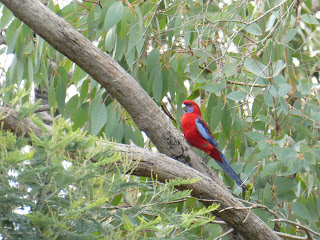It's hard to believe that it's been six years this year since the fire. While we have lost probably 15% of the trees, there are so many new ones growing - both eucalypts and acacias - that the property seems greener than ever. A mild summer this year with some rain helped, of course.
Saturday, May 1, 2021
Latest photos
Sunday, January 24, 2021
Covenanted property for sale - what does this mean?
What is a covenanted property?
It’s about conservation. About looking after bush and grasslands that are owned by private citizens. While we have both state and national parks in Victoria, Trust for Nature helps owners to ensure their land is kept for flora and fauna and protected from damage and development.
If you read this blog, you’ll see just how many elements make up this property. Not just the roos and wallabies and wombats and echidnas, but the many birds who live here, with their nests in the bracken and in the trees. As well as that, there are dozens of native plants I’ve found and identified, and probably many dozens more I’m not aware of.
A hundred acres with bordering properties
and areas of bush that connect with a state park to the north means we are part
of an important corridor for wildlife, allowing it to move around freely and
eat and live without harassment. It's a really important part of conservation in Victoria. There are few bush properties of this size.
After 16 years, we have made the decision to sell. We would love to find new owners who care as much about the property as we do. Who not only get excited about the wallabies and roos and wombats that come to eat on the grass area around the house, but who want to make sure it all stays as it is, for the future. Did you know in Australia that the rate of deforestation is accelerating? As is the loss of species? It’s hard to fathom how this can keep happening.
So we’ve had interested buyers who want to farm goats, have horses, let their kids roar around on trail bikes. A while ago we had someone who wanted to use it for a paintball business. We’ve had to say no to all of them. As we go for walks and still see new birds or find new native orchids after so many years of exploring, we marvel at our good fortune and reconfirm how important it is to keep the covenant secure and cherished, not seen as an obstacle.
You, too, can watch wallabies eat around the house before dinner, or wake to a bunch of noisy rosellas on the lawn (or magpies lately). You can explore the rocks in the NW area, or wander down to the creek and listen to the frogs. This is what it means to have a property of this size and live in the peace and quiet and learn about the land you are on, and look after it. It's not "a cheap bit of bush" - it's a large property with conservation front and centre, and a house designed to withstand bushfires beyond the current requirements.
Are you the new owner we’re looking for?
Monday, January 11, 2021
Monday, November 16, 2020
Monday, January 21, 2019
Battling pests of all kinds
It was somewhat therapeutic when I gave up normal weed procedures and took to about 200 of them with a home-adapted machete! It was horrible hot work but was worth it as since then the number of them has greatly reduced.
However, other weeds have emerged, in particular a pink-flowering thing called Centaury. Never seen it before, and now it just keeps coming. The only satisfying thing about that one is it pulls out easily, so it soon becomes a habit that every time I go for a walk, I try to pull out at least 30 or more. I'm pretty much on top of it these days.
On the other hand, there are native plants growing now that before were fairly sparse. One is the vanilla lily, of which we now have dozens in different spots. The bosseia has come back well, and there has been a big expansion in Running Postman with its bright red flowers. Lomandra has grown everywhere, which in turn has led to many more butterflies this year (I read somewhere that the butterflies lay their eggs in lomandra).
And there have been a few entirely new plants I haven't seen before, such as the Wallflower orchid below. With our efforts to keep weeds and rubbish plants from the house area, it's meant more native grasses have grown, and so our wallaby is now a regular visitor in the early mornings for breakfast.
Vanilla lilies.
Nine sulphur-crested cockatoos all fighting over their spots in the tree .
The Wallflower Orchid? Or is it a Broad-lip Diuris? Hard to tell from the book I have.
Wallaby for breakfast visit.
Many of the outgrowths from the burnt gums are persisting into almost-branches.
One of the oldest gums doing its best to come back.
Sunday, August 12, 2018
Friday, March 30, 2018
Trail camera near the wombat hole - solve the mystery?
So the camera was set up near the wombat hole nearest to the house. The camera has a night setting as well, but here our friendly wallaby has wandered in and is hanging around.
At some point after about three days, something pushes the camera over (which was on a tripod). Could well have been this wombat.
And here is the wombat again (I think) in daylight.
Yes, wombat again. Camera still in the same (sideways) place. What was that other animal?




































